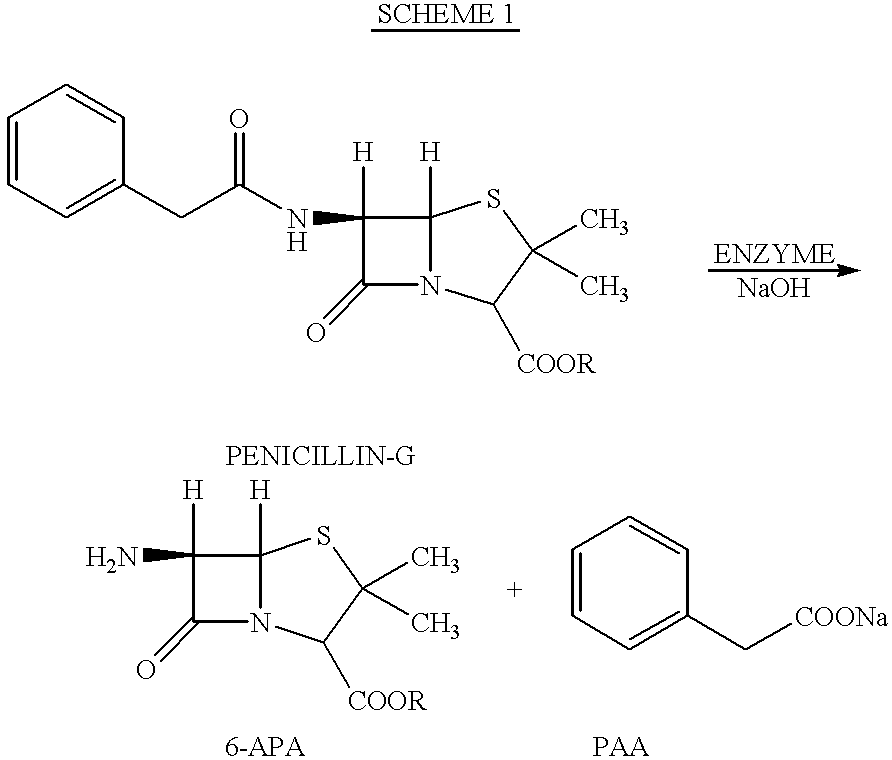Enzymatic conversion in a solvent mixture containing water and flourinated, non-chlorinated solvent
a solvent mixture and solvent technology, applied in the field of compound preparation, can solve the problems of relatively high cost and environmental problems, and achieve the effect of assessing the efficiency and selectivity of phytosol d
- Summary
- Abstract
- Description
- Claims
- Application Information
AI Technical Summary
Benefits of technology
Problems solved by technology
Method used
Image
Examples
example c1
Standard (known) method for the preparation of 6-APA
(i) Enzymatic De-Acylation of Pen-G
Water (480 ml) and Penicillin-G (30 g) were charged into a beaker in a water bath set at 37.degree. C. The mixture was stirred gently until the temperature was stabilised at 37.degree. C. Enzyme resin (38 g) comprising penicillin acylase on a polymeric resin matrix was added followed by 5% NaOH to pH 8.0. Stirring was continued whilst maintaining pH 8.0 and 37.degree. C. until a steady state was reached. This took about 2 hours. Total volume of 5% NaOH used was normally around 65 ml. The enzyme resin was filtered through a sintered funnel and the resin was washed with water and stored in a refrigerator for further use. The solution containing 6-APA and PAA was processed as described in (ii) below.
(ii) 6-APA Isolation
Enzymation liquor containing 6-APA and PAA was concentrated four-fold then chilled to 5.degree. C. and an equal volume of MIBK was added. 2M nitric acid was added dropwise to pH 3.8. T...
example 1
General method according to embodiment of present invention
Methods (iii) and (iv) hereinafter are alternatives, both of which can be used for isolating 6-APA.
(i) Apparatus
An apparatus for carrying out the method comprises a reaction vessel a d an evaporation vessel, both of which are jacketed to provide a means for temperature control. In addition, both vessels are equipped with reagent addition burettes, and a means for stirring, measuring temperature and pH. Both vessels communicate with one another and with a vacuum pump and a gas compressor so that reaction streams can be transferred from one vessel to another and a volatile solvent used (as described herein) can be transferred into and from both vessels and a suitable solvent storage tank. In-line filters, one-way valves and pressure release valves may be fitted to allow convenient and safe operation of the apparatus.
(ii) Enzymatic De-acylation of Pen-G
Water (100 ml) and Pen-G (40 g) were charged to the reaction vessel followed...
example c2
Preparation of 6-APA
The method of Example C1 was carried out to produce a baseline for comparison with other examples. In the method Pen-G (30 g) was reacted with the immobilised enzyme and the final product (6-APA) was dried, weighed and assayed using HPLC.
Results were as follows:
PUM
| Property | Measurement | Unit |
|---|---|---|
| boiling point | aaaaa | aaaaa |
| boiling point | aaaaa | aaaaa |
| boiling point | aaaaa | aaaaa |
Abstract
Description
Claims
Application Information
 Login to View More
Login to View More - R&D
- Intellectual Property
- Life Sciences
- Materials
- Tech Scout
- Unparalleled Data Quality
- Higher Quality Content
- 60% Fewer Hallucinations
Browse by: Latest US Patents, China's latest patents, Technical Efficacy Thesaurus, Application Domain, Technology Topic, Popular Technical Reports.
© 2025 PatSnap. All rights reserved.Legal|Privacy policy|Modern Slavery Act Transparency Statement|Sitemap|About US| Contact US: help@patsnap.com

